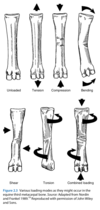Ch 2 Fracture Biomechanics Flashcards
(86 cards)
Most important mechanical properties of bone (2)
Strength and stiffness
Plot of measured deformation following application of known load?
Load-deformation curve
Regions of the load deformation curve
- Elastic region: measure of the elasticity of a structure. If the object is loaded only through the elastic region of the curve, it will return to its original shape when the load is removed
2: Yield point: the point beyond which the structure will no longer return to its original shape when the load is removed
3: Plastic region: beyond the yield point, the structure deforms to a much greater extent for a given load (the structure is less stiff) than in the elastic region of the curve. - Ultimate failure point: If the load is progressively increased, the structure will fail at some point. This load is the ultimate failure point on the curve

3 parameters for determining strength of bone
(i) the load that the structure can sustain before failing; (ii) the deformation that it can sustain before failing; and (iii) the energy that it can store before failing, known as toughness
What is toughness?
The energy that can be stored before failure
Where on the load deformation curve is the ultimate strength of the structure?
The ultimate failure point
How do you calculate toughness of the structure from the load deformation curve?
Area under the curve
Importance of toughness relative to fracture pathology?
The more energy a bone absorbs before fracture, the greater the comminution and soft tissue damage that develop at the moment of fracture. Greater toughness = greater energy absorption
What mechanical property is conveyed by the steepness of the slope in the elastic region of the load deformation curve
Stiffness; the steeper the slope, the stiffer the structure
Definition of stress
The force per unit area that develops on a plane surface within a structure in response to an externally applied load
4 types of mechanical stress
1) Normal stress is the intensity of the internal force perpendicular to a plane that passes through a point in the body.
2) Tensile stress - positive
3) Compressive stress - negative
4) Shear stress - the intensity of the internal forces parallel to a plane that passes through a point in the body, expressed as force per unit area
Units of stress
PSI or N/m2 (Pa)
Definition of strain
Localised change in dimension in response to an externally applied load
2 basic types of strain
Linear strain and shear strain
Linear strain
Causes a change in the length of the specimen (often expressed as % change in length)
Shear strain
Angular deformation (γ) expressed in radians
Appearance of the stress strain curve
Similar to load deformation; strain plotted on x axis and stress on y
Definition of strength of bone
Determining strength from stress strain curve
Stress at ultimate failure/breaking of the bone
Defined as the ultimate failure stress on the stress strain curve
(Remember STREngth related to STREss)

Definition of stiffness of bone
Determining stiffness from stress strain curve
Stress/Strain
Relationship between stress and strain
Divide the stress in the elastic portion of the curve by the strain at the same time point. Measures resistance to elastic deformation
Youngs modulus
The modulus of elasticity / stress-strain ratio (slope) when testing in tension or compression only
A measure of stiffness; stiffer materials have higher moduli
Higher modulus = high resistance to elastic deformation. Therefore don’t deform much before breaking. Even though ultimate load to failure may be the same, substances with a nigher modulus will break at lower strain ie less deformation ie more ‘brittle’ - bend less before breaking
Shear modulus
The modulus of elasticity when tested under pure shear forces
Mechanical properties of cortical vs cancellous bone
Cortical bone is stiffer but fails at lower ultimate strain (2%) vs cancellous bone (75% ultimate strain); cortical bone is therefore more brittle - sustains less strain before failure Cancellous bone can store more energy prior to failure vs cortical. It is much more ductile - can deform to a greater degree before fracture
Types of bone loading (5)
Tension, compression, bending, shear, torsion or combinations
BONE IS STRONGER IN COMPRESSION VS TENSION WEAKEST IN TENSION

Anisotropy
Exhibiting different mechanical properties when loaded along different axes





